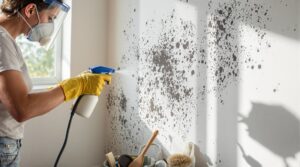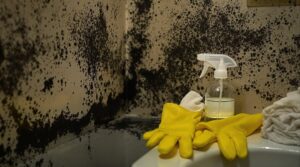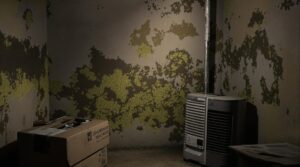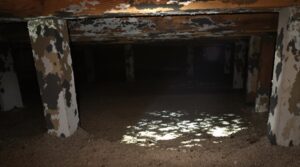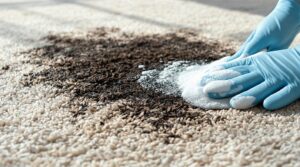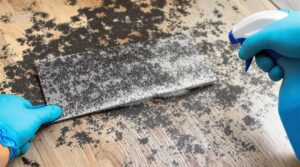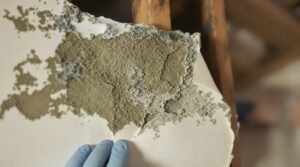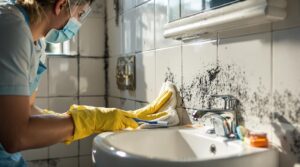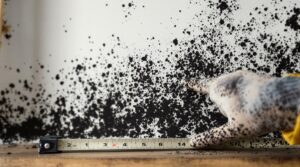Mold develops within 24-48 hours of water exposure in carpets, presenting in various colors including black, green, white, and brown. Common species include toxic Stachybotrys atra, Alternaria, and Cladosporium. Water damage from floods, leaks, and high humidity creates ideal growth conditions between 40-80°F. Treatment requires immediate moisture extraction, proper ventilation, and professional remediation for areas exceeding 10 square feet. Understanding the specific type of mold infestation determines the most effective remediation approach.
Key Takeaways
- Mold develops within 24-48 hours after water exposure in carpets, appearing as various colors including black, green, white, or brown spots.
- Common causes include flooding, burst pipes, high humidity levels above 60%, and poor ventilation that maintains damp conditions.
- Black mold (Stachybotrys atra) is particularly dangerous, producing mycotoxins that can cause respiratory issues and cognitive dysfunction.
- Visible mold growth on carpet surfaces typically indicates a more extensive infestation beneath, requiring professional remediation for areas over 10 square feet.
- Treatment involves immediate water extraction, dehumidification, HEPA vacuum cleaning, and maintaining indoor humidity between 30-50% during remediation.
Understanding the Causes of Carpet Mold Growth After Water Damage
When water damage occurs in carpeted areas, several critical factors contribute to the rapid growth of mold colonies. The primary catalyst is moisture penetration from various sources, including flooding, burst pipes, and persistent leaks. These incidents create conditions where water saturates carpet fibers and underlying padding, establishing an environment conducive to mold proliferation.
The extent of mold development is further influenced by environmental conditions, particularly when humidity control is inadequate. Even in cases where visible water has been removed, elevated humidity levels can sustain mold growth within carpet fibers. A wet-dry vacuum system should be deployed immediately to extract water and minimize potential mold growth. The immediate drying process is crucial, as black mold growth can begin within 24-48 hours of water exposure.
The presence of organic matter, such as dust, skin cells, and food particles embedded in the carpet, provides essential nutrients for mold spores. Dark spaces beneath furniture and areas with poor ventilation exacerbate the problem by maintaining the damp conditions necessary for mold colonization. These factors, combined with temperatures between 40°F and 80°F, create ideal conditions for rapid mold development in water-damaged carpets.
Common Types of Mold Found in Water-Damaged Carpets
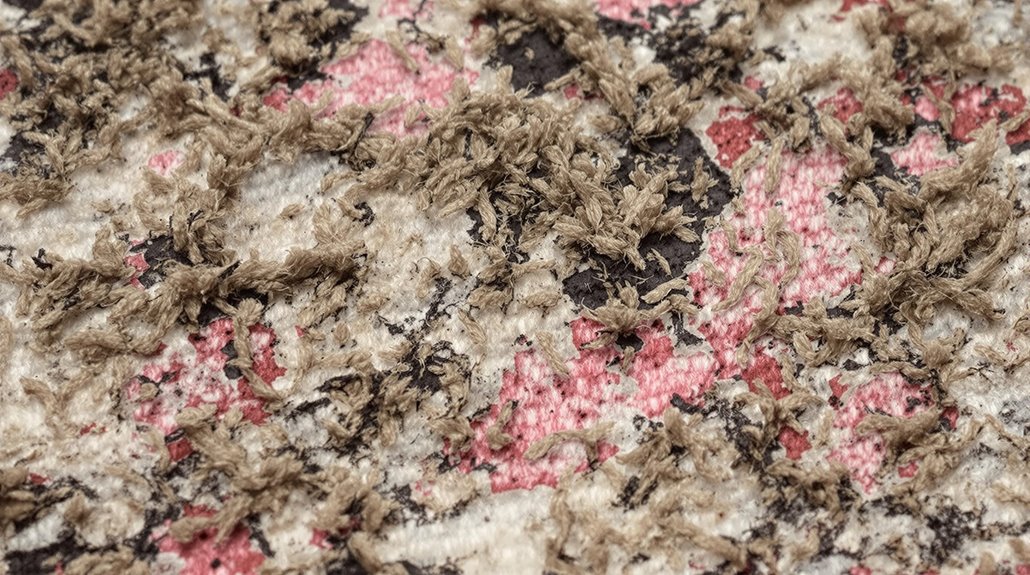
Water-damaged carpets provide an ideal environment for multiple species of mold, with toxic black mold (Stachybotrys atra) representing one of the most hazardous varieties due to its mycotoxin production and associated respiratory risks.
Common carpet-inhabiting species include Alternaria, which exhibits olive to black hairlike growth patterns, and Fusarium, which presents in pink, white, or red colorations. Maintaining proper home ventilation helps prevent these species from developing and spreading throughout carpet fibers.
These molds often trigger cognitive dysfunction symptoms including memory problems and brain fog in exposed individuals. Visual identification of carpet mold species relies on distinctive characteristics such as color variations, growth patterns, and texture, though professional testing may be necessary for definitive species determination.
Toxic Black Mold Dangers
The presence of toxic black mold in water-damaged carpets poses severe health risks to building occupants and requires immediate professional attention. Through spore dispersal, these fungi release mycotoxins that can trigger numerous adverse health ramifications, including respiratory infections, allergic reactions, and neurological complications.
Extended exposure to toxic black mold may lead to more serious conditions, such as fungal poisoning and potential cancer risks. Applying baking soda treatments can help neutralize odors and absorb excess moisture during the initial remediation process.
The mold typically manifests as dark spots on carpet surfaces, accompanied by a distinctive musty odor. However, visible growth often indicates an advanced infestation, as mold can thrive beneath carpet fibers and padding long before surface signs appear. Areas exceeding ten square feet of visible growth require professional remediation with proper containment protocols.
Prevention and remediation require swift moisture removal, proper sanitization, and frequently, the complete replacement of contaminated materials to guarantee occupant safety.
Common Carpet Mold Species
Several distinct mold species commonly proliferate in water-damaged carpets, with Stachybotrys atra, Cladosporium, Aspergillus, Alternaria, and Mucor being the most prevalent varieties. Each species exhibits unique spore characteristics and colony patterns that aid in identification during remediation efforts.
| Species | Visual Characteristics | Growth Patterns |
|---|---|---|
| Stachybotrys atra | Black with green tinges | Dense, clustered colonies |
| Cladosporium | Olive green to brownish-black | Dot-like spreading patches |
| Aspergillus | Various colors | Circular colonies on cellulose |
| Alternaria | Dark green to brown | Airborne spread patterns |
| Mucor | Grey to brown | Rapidly spreading clusters |
These species thrive in environments with sustained moisture exposure, typically establishing visible colonies within 24-48 hours of water damage. Their growth patterns and visual characteristics serve as essential indicators for determining appropriate treatment protocols. Professional testing using specialized equipment and procedures is necessary to accurately identify mold species and determine contamination levels.
Indoor Mold Color Guide
Identifying mold species in water-damaged carpets requires understanding distinct color variations that signal different fungal types. Green mold, commonly associated with Aspergillus, Penicillium, and Cladosporium species, appears most frequently and can manifest in various shades depending on environmental conditions.
White growths may indicate Alternaria or early-stage Chaetomium, while yellow formations often suggest the presence of Serpula lacrymans, which can damage wooden substrates.
Red coloration frequently points to Aspergillus species, requiring immediate attention due to potential health risks.
Brown manifestations, though generally less hazardous, typically indicate Pithomyces chartarum or Aureobasidium pullulans. While color variations provide initial identification cues, microscopic analysis remains essential for accurate species determination, as visual appearance alone cannot reliably indicate toxicity levels or specific health risks.
Optimal growth conditions include relative humidity levels between 70-90% and temperatures ranging from 40-100°F, making water-damaged carpets ideal breeding grounds.
Health Risks and Warning Signs of Carpet Mold Exposure
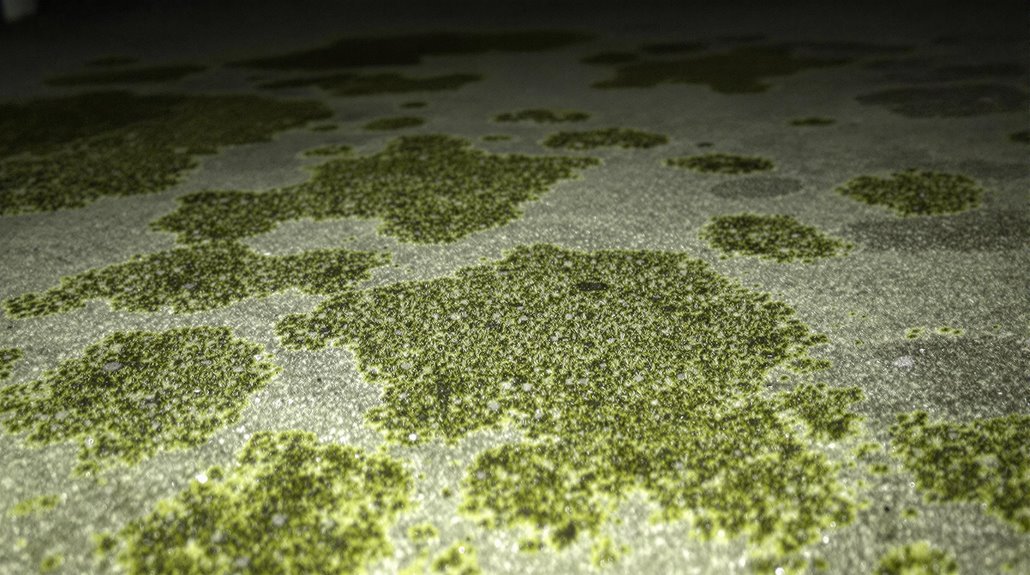
Exposure to mold growth in water-damaged carpets presents significant health risks that range from mild allergic reactions to severe respiratory complications. The health implications can manifest through various symptoms, including respiratory infections, skin conditions, and neurological issues.
Particularly concerning is the development of allergic bronchopulmonary aspergillosis and the exacerbation of existing conditions like emphysema and tuberculosis.
Symptom recognition is essential for early intervention. Key warning signs include persistent musty odors, visible mold growth appearing as green, white, or black spots, and physical symptoms such as frequent sneezing, coughing, and skin irritation.
Certain populations face heightened vulnerability, specifically children, immunocompromised individuals, older adults, and those with pre-existing respiratory conditions.
Prolonged exposure may lead to chronic health conditions, including bronchoconstriction, anxiety, depression, and in rare cases, life-threatening complications. Some studies suggest a potential link between extended mold exposure and increased cancer risk.
Mold typically develops within 24-48 hours post-flooding, making immediate water damage response crucial for preventing severe infestations.
Essential Prevention Strategies for Mold Growth in Wet Carpets
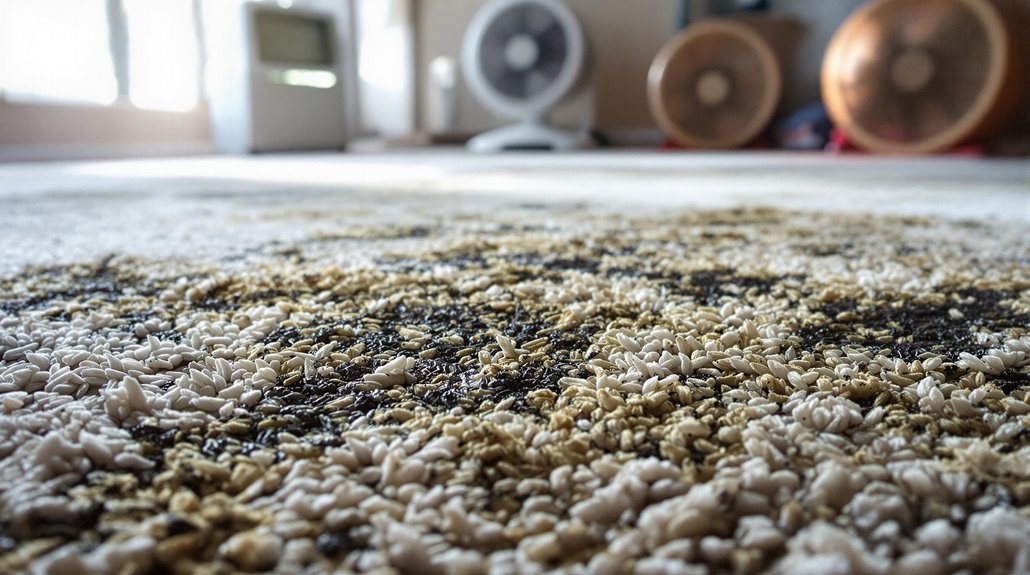
The implementation of effective mold prevention strategies can substantially reduce health risks associated with water-damaged carpets. Through systematic moisture mapping and humidity control protocols, property owners can establish thorough prevention measures. Critical steps include immediate water extraction, strategic placement of dehumidifiers, and continuous monitoring of moisture levels.
| Prevention Action | Implementation Method |
|---|---|
| Water Removal | Wet/dry vacuums, squeegees |
| Moisture Control | Dehumidifiers, desiccants |
| Air Circulation | Strategic fan placement |
| Surface Treatment | Mold inhibitors, baking soda |
| Monitoring | Regular humidity checks |
Professional restoration techniques incorporate both immediate and long-term preventive measures. These include thorough carpet extraction, application of antimicrobial treatments, and implementation of moisture barriers. Essential to prevention is the proper assessment of underlying padding and subfloor conditions. Regular inspection protocols, combined with swift response to water incidents, form the foundation of effective mold prevention in carpet systems. Maintaining indoor humidity levels below 60% through controlled ventilation drastically reduces mold growth potential. HEPA air scrubbers are essential equipment for removing airborne spores during carpet remediation processes.
Effective Treatment Options for Removing Carpet Mold
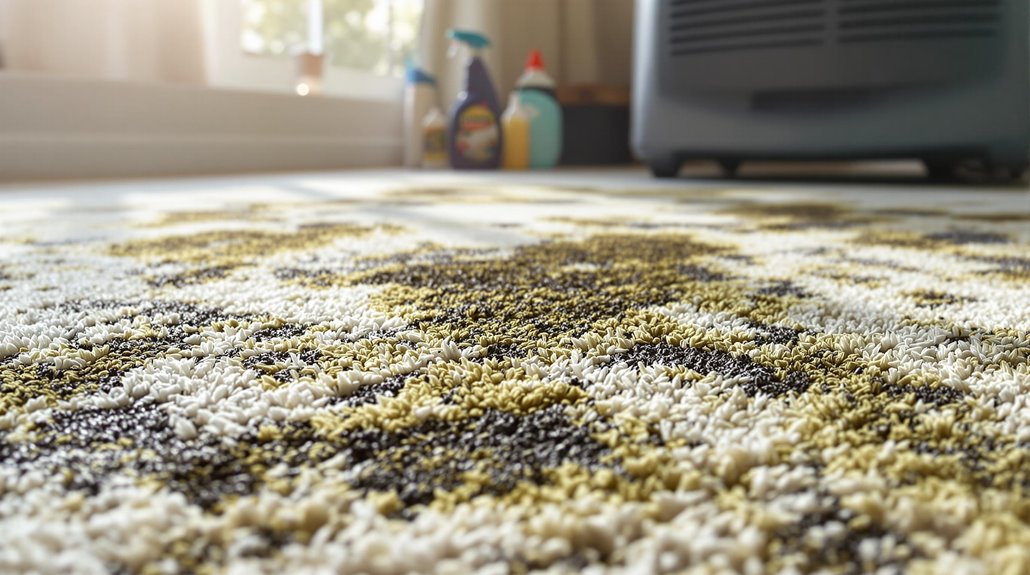
The treatment of mold in water-damaged carpets encompasses both DIY approaches using household chemicals and professional remediation services that employ specialized equipment.
Chemical solutions such as vinegar, baking soda, and hydrogen peroxide offer accessible options for minor mold issues, while extensive contamination typically requires professional intervention with industrial-grade equipment and expertise.
Tea tree oil solutions require proper dilution of 1-2 teaspoons per 2 cups of water or vinegar for effective mold treatment.
Following any treatment method, proper drying, ventilation, and ongoing maintenance become essential elements in preventing mold recurrence.
DIY Mold Treatment Methods
Several effective DIY treatment methods exist for addressing mold growth in water-damaged carpets, each requiring proper preparation and safety protocols. Before initiating treatment, essential safety measures include proper ventilation, area isolation, and the use of protective gear such as face masks and rubber gloves.
Natural treatments utilizing vinegar and baking soda mixtures can effectively eliminate mold and associated odors. Steam penetration, when applied for a minimum of 12 seconds per area, achieves approximately 90% mold destruction.
HEPA vacuum cleaners remove surface spores and debris, while stiff brushing helps dislodge visible mold. Commercial anti-fungal sprays and cleaners provide additional treatment options when used according to manufacturer specifications.
Post-treatment, implementing proper drying techniques and maintaining humidity levels below 60% through dehumidification helps prevent mold recurrence. For moderate to severe cases, professional remediation services typically require 2-5 days to complete structural repairs and ensure thorough mold elimination.
Professional Remediation Solutions
Professional mold remediation services deliver complete treatment solutions for severe carpet infestations through certified specialists, advanced equipment, and proven methodologies.
These experts employ industrial dehumidification and advanced ventilation systems to effectively control moisture levels and eliminate mold growth.
Their exhaustive approach includes thorough assessment, containment, and treatment protocols.
Key components of professional remediation include:
- HEPA filtration systems to capture airborne spores
- Industrial-grade equipment for moisture extraction and drying
- Anti-fungal treatments with specialized cleaning solutions
Professional remediation specialists not only address visible mold but also identify and treat hidden growth beneath carpet surfaces and padding.
Their expertise guarantees proper containment during removal, preventing cross-contamination while addressing underlying moisture issues that contribute to mold formation.
This systematic approach delivers lasting results and helps safeguard occupant health.
Certified technicians maintain indoor humidity levels between 30-50% throughout the remediation process to prevent future mold growth.
Prevention After Treatment
Maintaining a mold-free environment after professional or DIY treatment requires systematic implementation of preventive measures and monitoring protocols. Essential prevention strategies focus on moisture monitoring and ventilation control to minimize conditions conducive to mold growth.
| Prevention Element | Implementation Method |
|---|---|
| Humidity Control | Deploy dehumidifiers and HEPA filtration |
| Surface Monitoring | Weekly inspection of treated areas |
| Ventilation Management | Cross-ventilation and air circulation |
| Rapid Response Protocol | Immediate treatment of water exposure |
Post-treatment maintenance includes regular carpet cleaning, prompt attention to water spills, and maintaining indoor humidity levels below 60%. Installing moisture meters at strategic locations helps detect potential problems before visible signs appear. Implementing proper ventilation systems and maintaining consistent airflow patterns substantially reduces the likelihood of mold recurrence in previously affected areas.
Identifying Signs of Hidden Mold in Water-Damaged Carpeting
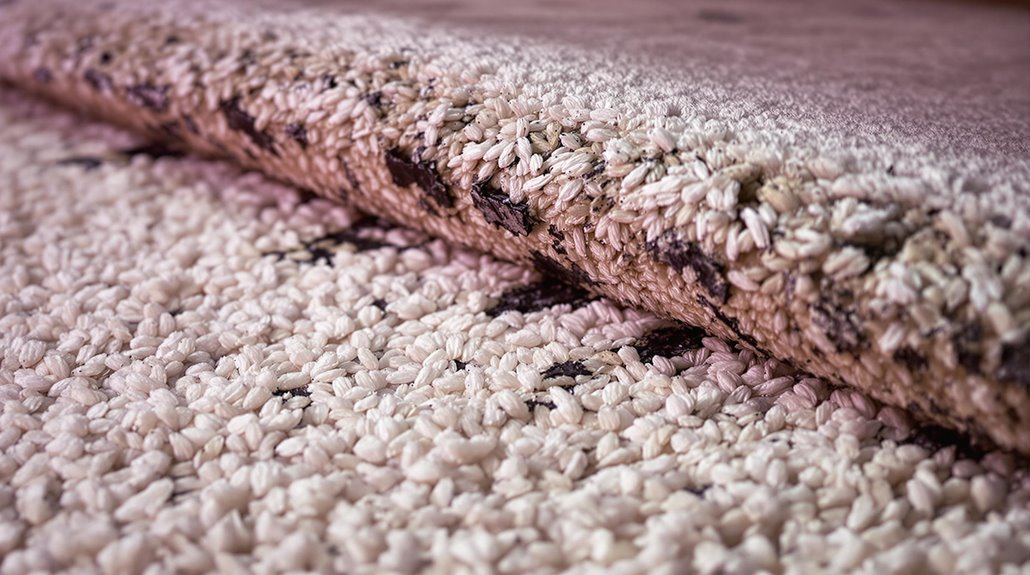
When water damage occurs in carpeting, identifying hidden mold growth requires a systematic approach that combines visual inspection, sensory awareness, and analytical testing methods.
The presence of moisture patterns often indicates potential areas of hidden damage, requiring thorough investigation beneath the carpet's surface.
Key indicators of concealed mold growth include:
- Persistent musty odors, particularly in areas previously exposed to water
- Unexplained discoloration or dark spots on carpet fibers
- Physical symptoms among occupants, such as increased allergic reactions
Professional inspection methods utilize specialized equipment to detect moisture levels and potential mold colonies.
Visual examination should include lifting carpet edges and inspecting the padding underneath, particularly in areas where water exposure occurred.
The combination of moisture testing tools, thorough visual inspection, and analysis of environmental conditions provides complete assessment of potential mold growth.
Regular monitoring of previously water-damaged areas helps guarantee early detection of recurring issues.
The Benefits Of Consulting A Public Adjuster
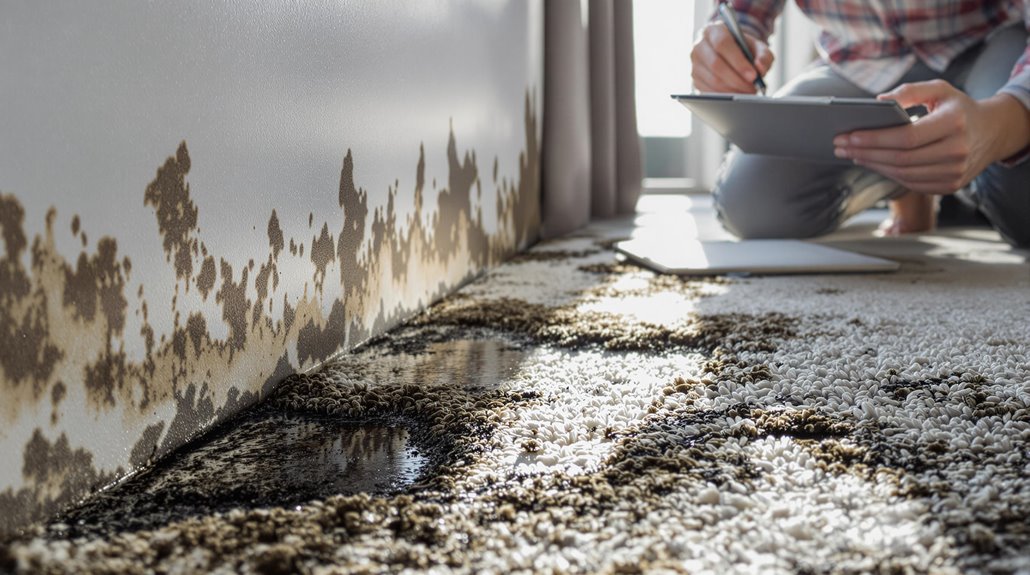
A public adjuster provides professional expertise in managing complex water damage insurance claims, ensuring accurate assessment and documentation of mold-related carpet damage.
Their objective evaluation methods and thorough understanding of insurance policies help maximize claim settlements while streamlining the entire claims process.
Public adjusters handle all aspects of claim documentation and negotiation, resulting in statistically higher payouts compared to self-filed claims.
Expertise In Insurance Claims
Insurance claims involving mold damage from water-damaged carpets require specialized expertise to navigate effectively.
Public adjusters possess thorough policy expertise and understand the intricate details of insurance coverage related to water and mold damage.
Their professional knowledge guarantees accurate claim documentation and proper presentation of all damages.
- In-depth understanding of insurance policies enables adjusters to identify all applicable coverage benefits for mold remediation and carpet replacement
- Professional negotiation skills help secure fair compensation by effectively countering insurance company tactics
- Meticulous documentation management guarantees all damage assessments, repair estimates, and supporting evidence meet insurance requirements
These professionals streamline the claims process while maximizing settlement potential through their technical knowledge and experience.
Their involvement often leads to more favorable outcomes for policyholders dealing with complex mold-related claims.
Objective Damage Assessment
Professional damage assessment through public adjusters provides property owners with thorough evaluation of water-damaged carpets and resulting mold issues. Using advanced diagnostic tools, adjusters conduct exhaustive moisture mapping and surface testing to identify both visible and concealed damage patterns.
| Assessment Component | Technical Approach |
|---|---|
| Primary Inspection | Thermal imaging, moisture meters |
| Secondary Analysis | Air quality testing, mold sampling |
| Documentation | Digital mapping, detailed reporting |
This systematic approach guarantees accurate documentation of all damage aspects, including moisture seepage, structural compromise, and potential mold proliferation. Public adjusters utilize their expertise to interpret findings and translate them into detailed claim documentation. This thorough assessment supports maximum claim compensation and guides effective remediation strategies, protecting property owners' interests throughout the insurance claims process.
Streamlined Claim Process
Public adjusters streamline the insurance claims process by providing thorough claim management services that substantially reduce administrative burdens for property owners.
Through process optimization and claim automation techniques, these professionals efficiently handle documentation, communication, and negotiation with insurance companies.
Their expertise enables faster claim resolution while minimizing stress for property owners dealing with water-damaged carpets and subsequent mold issues.
Key advantages of utilizing public adjusters include:
- Professional management of all claim-related documentation and deadlines
- Expert navigation of complex insurance policies and procedures
- Exhaustive damage assessment through collaboration with specialized contractors
Their proactive approach to claim management guarantees that property owners receive fair compensation while focusing on recovery efforts.
Public adjusters' systematic handling of claims expedites the process, allowing for quicker implementation of necessary mold remediation and carpet restoration measures.
Higher Claim Payouts & Settlements
Property owners who engage public adjusters consistently achieve higher insurance claim settlements compared to those who handle claims independently. Public adjusters leverage their expertise in policy interpretation, thorough damage assessment, and strategic negotiation to maximize claim payouts. During claim disputes, they identify hidden damages like structural compromise and secondary mold growth that property owners might overlook.
These licensed professionals manage all aspects of settlement negotiations, from documenting losses to counteracting lowball offers from insurance companies. Their contingency-based compensation model aligns with the policyholder's interests, as they only receive payment based on the final settlement amount. Case studies demonstrate significant increases in claim settlements, with some payouts increasing by up to 50% when public adjusters represent property owners, particularly in complex water damage scenarios involving carpet mold contamination.
About The Public Claims Adjusters Network (PCAN)
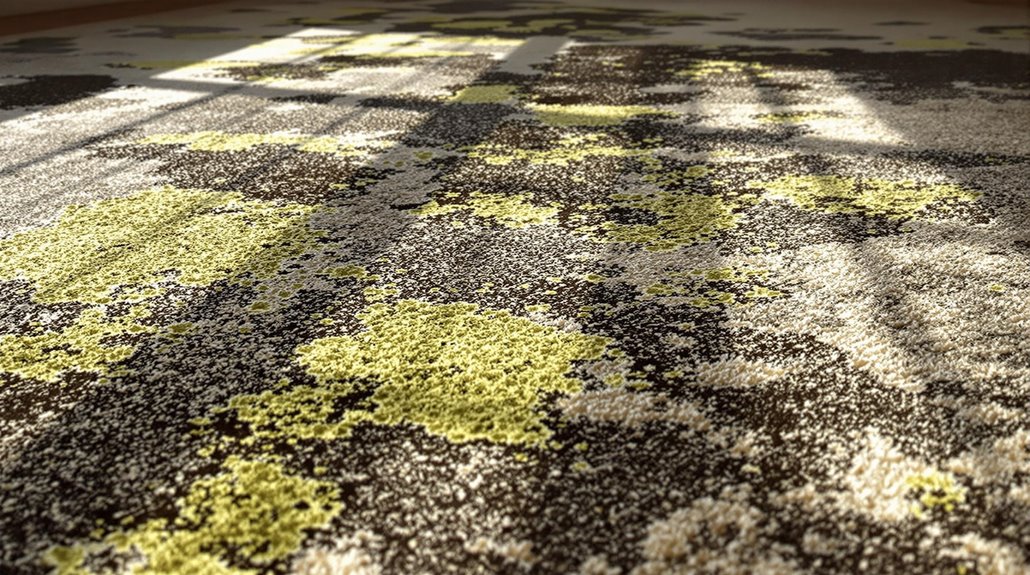
Insurance specialists within the Public Claims Adjusters Network (PCAN) represent a nationwide coalition of state-licensed professionals who advocate exclusively for policyholders during insurance claims.
Through Adjuster Certification programs and extensive training, these independent professionals possess the expertise to navigate complex insurance policies and maximize claim settlements.
Network Benefits extend to policyholders through thorough claim management services, including:
- Thorough damage assessment and documentation of water-damaged carpets and resulting mold
- Strategic negotiation with insurance carriers to secure maximum settlements
- Professional interpretation of policy coverage and applicable compensation
PCAN adjusters operate independently from insurance companies, working solely on behalf of policyholders.
Their contingency-based fee structure aligns with client interests, requiring payment only when successful in increasing claim settlements.
This arrangement guarantees accessible professional representation while maintaining focus on achieving favorable outcomes through methodical claims processing and expert negotiation strategies.
Frequently Asked Questions
How Long Can Carpet Stay Wet Before Mold Starts Growing?
Mold growth initiates within 24-48 hours in wet carpets when moisture levels remain elevated. Immediate drying interventions during this critical timeframe are essential to prevent spore colonization.
Can I Save My Carpet if It Already Has Mold?
While carpet cleaning techniques exist, salvaging moldy carpet rarely succeeds due to deep fiber penetration. Professional assessment may determine limited rescue potential, but replacement typically offers the safest, most effective solution.
Will Homeowner's Insurance Cover Mold Damage From Water-Damaged Carpets?
Coverage depends on the water damage source. Homeowners insurance typically covers sudden, accidental events but includes insurance exclusions for gradual damage. Policy limits often restrict mold remediation reimbursement amounts.
Does Carpet Padding Always Need to Be Replaced After Water Damage?
Carpet padding replacement isn't always necessary after water damage, though cost effectiveness diminishes when contaminated water is present, exposure exceeds 48 hours, or visible mold appears beneath carpeting.
Can Air Purifiers Help Prevent Mold Growth in Water-Damaged Carpets?
Air purifiers with HEPA filtration effectiveness can reduce airborne mold spores but cannot prevent growth without addressing moisture circulation. They serve as supplementary tools alongside proper drying methods.
References
- https://thebestrestoration.com/reduce-risk-of-carpet-mold-after-water-damage/
- https://restoration1.com/minnetonka/blog/different-types-of-mold-to-look-out-for-after-water-damage
- https://www.puroclean.com/aubrey-tx-puroclean-aubrey/blog/mold-in-carpet/
- https://advantaclean.com/ft-lauderdale-fl/about-us/blog/how-do-you-prevent-mold-under-wet-carpet/
- https://www.puroclean.com/plymouth-meeting-pa/blog/types-of-mold/
- https://servicemasteroflakeshore.com/mold-carpet-water-damage/
- https://www.wilmar.com/info/remove-water-prevent-mold-in-carpet?ab=rc_ir_mf_preventmold
- https://www.premierrestorationservice.com/common-mold-species-water-damage-restoration-in-brunswick-ga/
- https://content.ces.ncsu.edu/water-damaged-carpets-and-rugs
- https://www.branchenvironmental.com/toxic-black-mold-on-carpet/
